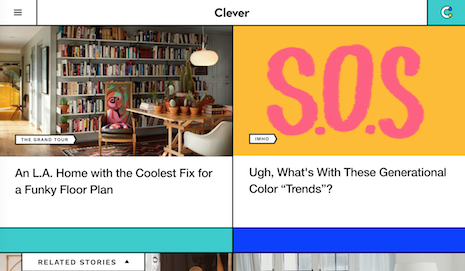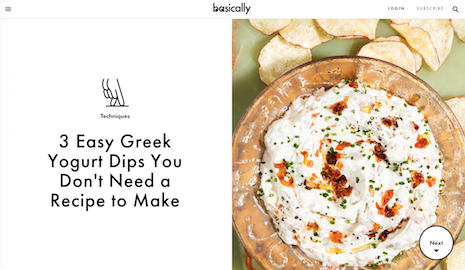Media conglomerate Condé Nast is putting additional stock in digital content hubs with the launch of title offshoots meant to accompany primary print publications.
Condé Nast has recently ramped up its digital properties to cull millennial readership and to attract advertisers that appeal to the next generation of readers. The media group’s millennial-centric developments includes the “Next Gen” campaign and digital companions for titles such as Architectural Digest, Golf Digest and Bon Appetit magazines.
"Millennials and Generation Z take a digital-first—and especially mobile-first—approach to media, so it’s a no-brainer for any legacy company wishing to remain relevant in the future," said Rachel Saunders, strategy and insights director at Cassandra, New York.
"However, more young people are telling us that they’re turning to analog entertainment to counter the always on, constantly connected nature of their lives," she said. "In fact, 74 percent of U.S. and 68 percent of U.K. youth told us they enjoy tactile media experiences.
"Though we don’t anticipate the decline of digital anytime soon, there’s still a market for physical media like magazines with the right kind of consumer."
Ms. Saunders is not affiliated with Condé Nast, but agreed to comment as an industry expert. Condé Nast was reached for comment.
Reading the next generation
Back in April, Condé Nast debuted its Next Gen campaign, which was designed to show that the publisher’s titles lead the conversation online and in print.
The campaign was created by Condé Nast chief marketing officer Pamela Drucker Mann and creative group heads Raul Martinez and Alex Grossman.
Condé Nast Next Gen appeared in video, mobile, display and social ad units and was intended to reflect the publisher’s business strategy to its advertising clients.
The push toward digital content hubs stems from the success Condé Nast has seen from Teen Vogue, published quarterly to focus on digital content, and Vanity Fair’s The Hive, an online-only news and op-ed platform.
Condé Nast is now expanding its digital content concept to additional print titles within its stable.
Shelter publication Architectural Digest, for example, has launched Clever, a new site “all about design advice for real life.” Clever comes from the editors of ArchDigest.com and takes a more realistic approach to interior design topics.

Architectural Digest's Clever. Image credit: Clever
The launch comes shortly after former Teen Vogue editor in chief Amy Astley joined the Architectural Digest team.
In its introduction, Clever explains, candidly, that design is hard and that “the editors of this site are probably a lot like [the reader]” because the Architectural Digest standard is aspirational.
Topics covered on Clever will include style hacks and “Pinterest fodder,” before-and-after renovation content and conservations for real life design testimonials.
A similar site, The Loop, has been launched to speak to millennial sports enthusiasts. An adjunct title to Condé Nast’s Golf Digest, The Loop is a “modern handbook to sports, entertainment and everything else.”
Over at Condé Nast culinary titles, Bon Appetit and Epicurious, the publisher has introduced the Basically and Small Plates content sites.
Bon Appetit’s Basically speaks to a millennial-aged audience through recipes and gastronomy-related content. Basically’s tagline sums up many millennials, saying, “Can’t cook? No problem.”

Bon Appetit’s Basically site. Image credit: Basically
With millennials now starting their own families, Epicurious’ Small Plates is geared toward a modern audience with children. Real-life content includes recipes, strategies and thought pieces on family dinners, food allergies and packing school lunches, among other topics.
A common trait across the four content hubs is a minimalistic design that includes white spaces, larger text and is heavy on the imagery. Also, the sites do not have much ad space, besides a top banner unit, opting to rely on sponsored content instead.
All audiences
Condé Nast’s next-gen strategy is also focusing on marginalized audiences.
Last week, the publisher’s incubator announced its first project, a next-generation community platform geared toward LGBTQ youth.
Launching officially Oct. 26, “them” will celebrate the stories, people and voices that are emerging and inspire with topics ranging from pop culture and style to politics and news. All content will be told through the lens of today’s LGBTQ community and will be lead by Phillip Picardi, digital editorial director of Teen Vogue and Allure.
When them launches later this month its first advertising partners will include British fashion house Burberry, Google, ride-sharing application Lyft and the Gay & Lesbian Alliance Against Defamation (GLAAD) (see story).
As Condé Nast continues to develop digital properties, strengthening the relationship between millennial readers and primary print titles could be possible.
"That depends on the execution—it’s too soon to tell," Cassandra's Ms. Saunder said. "Perhaps a better question is, what value add are the new hubs providing that the primary titles were lacking?
"We know from our research that young people are hungry for culinary and home-related content, but Condé Nast will have to do more than optimize its content for a mobile audience for it to resonate," she said.
"What unique voice or viewpoint are the new hubs providing? They’ll need to hone that if they want to cut through the clutter."
{"ct":"y6QStu3pInrL3wnbjiKNpugGsvFFxcw\/Dn5eVDUHo270FYX2dNytRRpTnKJSjKXNKNrJQmd35ZPH3nc5EXZgm1JPH23L35rKmngRGsFcUHxYTJ8REQLLSROBtsyAz8pg+QZ+lgL1ruz9Zs9CykfKkhNeJFkZh7jO5bbNVSGM+6HimeCmjxzLb1Hkmag0d9TAm1C2hYyJ9DWV9y9olGJlylTsrAGqiW5jQ2VrYoBPv28QfPk+kL1USCnM9cevq99b8RZXRgmhAOcuAwzGQGdcKu+AuqkR\/xVvGaPq+tWyB8B3zJGCGStwqtr6\/wovE1wdEu8eZvFGih1V2x\/rMM4gKTc5\/22GKYifJ9F3sXICPm9\/KFT7SAgwIbvfkJXLi02x6mmQ2Nb+aQWyKLAXkvlPL354l4ziOb6LhK0j21L\/5CIRwA28MNTAv3u330qBiCSsLKnF+bR3MSpG+Epg6MjhB+HLrusTRAB4Iuq4C2A\/+TyFXU2jWIFenQMtYS5OGZ\/v+zVfEAKSh\/GdspzhULkYBWGIZwVO7VIL1Bh5ReS1VYtj4S8GOOnv0f9nysPDqMT2lZlRYQPl64s9x\/e9JPuK0\/+Mzddp6hQ\/uGjuOqoCS8pZ3yM2I2aTFciCmzQoPz1IhziQPfm9eIcfLaQzxMe1gtPIu\/luOHL0Pv1dEMxeJvugvsHFu9JC+ecVud7NRnvjEc+TUFZhbuhUrCO62ve1rQmGBsoX\/KyzdTLZg4X115fgHJx9kyZA9d3GypjhCWXDe2XqKrEODJRXQZak3FU7ReWDO7+Wudnzh0NQAGAyF64rmezKLNusPFFyyn3vwioJ9lRAmcsuPa2jQl64kWok80Q2bDWsS2K9GmSOHjYLHUc45h+ObNzaNnoVcCWgEYaX\/58Kl+m32cqUT7UnIkjsTbHf4WU7MyUVbdb3BoLTB829Dok8ra6xHABFy4eCGwozOi7BgNd0tGXtZXYBex2kvEbsVMjDLSu7uNgLUHGl8lgRKLfAoRnjhV8fHmYh5shV8VH0CIil7C00WqcEmcEkfyg3wM9LHwBOr8+rDr5YnuJ3K8TmnQWcBkfPKOiRG9ky8dVvQpDlDpEOQ89TUFWDoP\/IjkMX0U7Y1G8cdBFzBVvZV+q8k6j7rinFTq7dCJYPn8k2snHPH1Lpv9Ph\/0rw0gcibAp\/dua8KOY8BFVxmgCHr+p6WtE1XOyF3jjh1I98TpgXhKc3O+382nmdZn393SH2qo9VYu50ZCNnENWoRbKfICxCGqhCD4BRrL+CHlf0NcqrTRoqRE3WIQ9xNKd23BgpngLL+fS06yuf3ZqSSELnqdQsDf9QmohxQwEtX1H6W5mV0+dYsORXv\/hxs\/GRNO33Vls0lCUV+bw4Ss3OySMJj3vwLuwpihFVZrW8nND3MS0QfUp\/0qKPBmkAdzNVpvqSJMl49M0w\/ra0uIoOqn\/4A9C\/8MfL+6axYGOi1HqYsbHoO+a78ZsN7p0ewT1JLLN8ifWOLSIo5P8dU6aHOzn28L+Ev\/w5+8SAQvShRFckG\/4EG1lVfO0yDztyrFD4dWb0b2Gsxpj2vQk1gvZ\/3MBZkD4FXnsHyJkJ+Rlx\/yvG46vQILoL+QSn7v1vO73xWm5S6CpW34CuhywAtqTUw7tIhR+KGFTwzItqMQSvRwvrXd6hzJAb0p+DZ9NsyhwCAeHHoy2OW3vwTC1ARB8NwUFf1O4nJXlTdTvjQr6\/uqB9zALpAqt4HolxulOjLYT4pVdbGKk4t9YP9XBHWxK1v6xSZ9yQexYw+KB1Qje6QTqHEoqYwNaUA+u+nfgXAifJxLGTDGzxUbp69pYm8mGB+vbzxa3xe97fnI+QJk9JUXYVxYa+T+Rx8wL\/gwLD1tz1QSwvdgAlOPaEhHrYtyRRxkyf4mHss\/VatnAm4V6dD7uNWgz6RIK+tnfo2OAIGx2TXQmcsn9HBuVVXTCgz3gUcBfQL2hZZ4+4eqolPODWzN2Fnm\/x18V3rxe6m9L4RVtb74VYjixniJpW2ncV9F2zYZ0UF+aHPsvrNMRuDuXjR9DhO\/H6uud2CcfNZMIK7rqxLqUOmy5UB\/rjjIzsHWTU2ilCB8Hb3SPOoaQYzHAuZ3MR3a6Plo0RjHndchznRCnMo2CekyxEwuJw49qcwDcT5Bb0IswRM+BGAkEbdu1emuJgoU0I73MjDvvr71CaPSfc4r8susRJW2+d3j8Oi6957kL2Sn+MwREF1oMOFDwvi\/Mx1gFHkMOsQptpX7NlJxySPZRmcF+YXDEu6eqBD3dvTIjcNIR1n\/8r5d8qOsthfW5jzCYDpAUKX6BAqSvEgfuXx1zEXVLFsh8Z6sPhjMRE9sA72MnKiNZNS4qiEoPBGFW62GsouSJn2\/mP6KwZWv7JPoivMrwf5rxCSZmrhwWCtvk2WVxd41cp2EBHkOCvAL+JVJQ557mbc0FVXtxBwOvXq+1CCxxQ6iJQPUG3d9FXD3lQwJ7fcNPakaQRFOC1mm95gK9qI6vPjKhi87UfV0MBJPedWNtC1rG3bOXNZfcg4ZeFEkjv5IsH7bXeaBuT8AuKrdPl1gAlvwVdw83u95bsi485ghvpWNSTfoY9D0vg95zmKCb15\/9cX0JuixNbRuxaGZtKWPb+2GqyjTEGgx1RnD7S5F9OLofW\/Ba4dgl9pUFXmcGCWunA+Zdzat82rdMrBHIjNgK0abhBsxFlB3r008xtTHum+k0OpEIuiSXoNTUz4Q65mYsla+IF7RLJuDMyTA\/NbPcAw+mVjPPr36OR4YIrY3GTXWyOw5MYTD+UhZ\/XfEQDSw2XKG1KLFl7Kz2uPYglV\/beLaBXZKsjHLPqloRY+S8Itx0Spbo6EENz8Kwtsod7KSMnH9PMhahYocEyln4dTSfz+zrB2gwOxUYyhRaEbQCoyNHh1DLo7b7tTKNzAVM9IUP9kL2u3hZdWNOKL4uplZbGB\/Mym+zThYNYYug7s+TOt2B8eqieph8IWld06MAFbYjBHFmmPAgSUqGNKTIFVKH7z89MFGSPxIiIxGpX6lT1Q6ortidWlrlZ3Uknced1LoCe+YgN6AN29JAgnD5kmzw4djgcK0LC2NQLIq1HBkIvdOgQRKnqBtPu0W2LKywM5Il9sY8aoXewukbSJOy\/vhML\/e4h2ae2DzWhkENtVOg3NoIcqMI4gQCiWqBhJAm3V9t37S3gNrOjmaPne\/VmTOZxVkKdujNUVVyibcPmOhdp+G5l42oo0mH+otQFuh6XFmMwURwP1JDlHXVvQE+FF8sjWFrsdxj4t5OZsVFRxnCVFsIWJ4Dzd8MtHKBUYySfiHOywDzfXax4xrBW2diVqdMvdkBbKA5XQHDcofF7WtBfmq2T2NzgmLzmlfnl6OI3bO\/qfPiK+fJOZPJPuraSfba+TDZtPPdALbEu+sY5AQBmexy2NvKbxnCCu8rdZV2X1BEJh3WDE\/Ux9VxmG6IgAO3+I2MiBx3CSsaL272tTSk4HwcV1NalbdcdN9upFzCReSRvxCn7u5h+uNueWqkA0va68Xk5MLANotJjIRkbyJmvxoxHpHWmZXH+7I8lHCzKkaqY++NyljJ7VH8pFXeslUM4nmXEQhIy1bHzXrJf9xU0OD4ygnG3NnqD0DoYOyV+APsv\/rCGYVYxdsTvOh7WjeIXKjlnruAbvmK7SkUTWThJ9jSFys7iMAbYdqMRZeXIyk6igMSyH2DSlZ+8mw6\/tCzI9+8hki4SdgnYQBQMHRn3CY64qB1mZ\/NeG2QYZnw8n3BbhO+CZRTt6LZ72AWQWZRcrFiWptLe807EeA6GM6q9qcK6lRMd9cdk7BZd6lwwAJYRts9BQTn4QsLT7N3a4UkFawgduughM0IWSJPa5Z\/7NbhO7UijU7fDks9EyevfK6qcAY009lEz4DXXTAOnbh4JSMuYypee9hrLRPTt6+IA6Oi1Wu6oKPLfpnAaDkyDa6F+1Ge8\/0Aud+Qq43JPN\/yoNIp7a3dMRh8Xyv2fCOMZ+TfiLwkj4v0onRaOa84D52NEQ9vrCpkKrPLL6oMEfdd15rMZZLmTFXcwbu5elntWTncr4RPZhb9J76k6OSJeGPV4cM5bcdBvSET6mH\/1Qv+TO1pHnISQ2uPYuOQ43bcQWE6AGUrvkq89wwBWvg5qe5\/2MJm7KfuwZM\/4osPXE6I3W0PsN1M7nTJk7P6LngC+\/r8YVZ0kp3NfDokImrFUwnLRDfgw37tezvHCnkRnFh9oTY09o2qndH1YCnMmyxj8KNhRjY5k3cCW\/8pZwYcX58lyUCECb4jHQjlrhnYsCBCeKzpRlxgxexuGXxClSCcagWOTkvNPCF6CIO35Qxs3i93hFvcR0aILLOPW+begxHTQvCvrn0Qn6SPM+q2tYeEan4WRZbrMHiaexdrZZaT\/zrgr1PfVnbXOLlYXnVzyj3uJuUIld6yw+CEJDVBLs6QjJ0faFPaicm8FGUqNWFfEph1llUwmVXgnvFhQsEnDeda+Sv4hyyQkoZBnrP6zeU50SZH9KrwajthfKvxtlKpkI1oDt4mXVn+j\/MdnxdqkJqBf2GiAFOsiW30Y71YKRg3pu9447uhQVg2J93Hd6aSrWnjSa40O42h\/iypkpF6oqZDt5AW87swb25zfm2ErcfcP6axyaqI9BWwNVjOzVNkp+\/ZI91BJp93oVNDPaGGkai+UJPFL0CW2smRsZHj7WA7n8g9BtVASPvfsXl19XkHEA\/QL8nsyxtBSbYX9xgk5sg4FVrLgsxt7FSGf\/G0fVASUx6eUoX5F\/hI2qpBr3TCklYUJdBz+HOctU9F+77NZ7H7Z2Y0ldCs+rdDS07i0eKNpgTA7by9KoNIa5mgu2U\/phhKCEczuS8hyPcqmOFbVbrSFmXiIh2+UlCthtonlixOFpQ60DbfI7JEjILPCsAsv51wEtFq74UjK9PFDjPo82JfJzlj\/QgVcYK1BX1qzu0dGG8N4fsXk2Y\/jNpOb\/bxIyCkQkr1aTtuFy4FBsd\/CIjFoZZEhwA9JSdPI4JhPcim0nFDvv8qCvej9wsONRfxLdS183Ez7ZIZAZRvYZa\/jA+GocYmiNq+t2qzLRUt0RIjGILUvkXbA5Da7TPl8nkuD2HKbFTx8\/GnU1xJLIMrOLfItu\/qGl0nc63GyGfLEA085ch5XI3HIG7Ta4SwmAcDXlgUjjPBn0v4nMXFnAlYwddab\/wY8X0gBQaFXeTpavVTR0t2zYdLgAVBfkwSdiUK77cX3VHCIB\/1gdX5Chy3Yj4bgdUzz5wLgGjtGkmmYrmOZACqvJwMKXhvVcyJx9+zfiJnCNsFfHt7TvDtpNnfX0CaP7QtrIed54SZM08bFAOcTZXbJUiAODCoP2tBpMN\/T9u\/H4J1XRtQ6OJKJ8BVfsjFbpeGP4rrU68n1IIw9P2kqznU1n3l\/OedtufWq9FrbmzVDByvYzMFZKUSfZKwnmEGWvVmSnIq5EPz8NG\/4IjTKdStNvUvV2MvoUVpzpnXDZhETkfS4CrC56BxiD7lmXAZlWEUDUob31X27bWrVo9ZO8UQr+NXw6NjeuSnPergIKGkKKKzXHvSIsR6DPDAeBzftGcgil7lWv0mlMeYkd2OZM5hgmBAUkoTKfFXO+yHvGTsaX3qdue2ZHxZd4t3M+VI0b224UF61wjzRFXWGeH65HN+xAKZcqmaXmU64t3U5BuGWA0Yt3QdkK1FXaUf1VPvJDkwd72qclvCxMOp3JLZPWp752qSzaEGduLGPnb4yB4NmBdlFLRmNxTnw8TsTi23xFr8sttnOzLlKAymN01LUMbBcs+uN47LHThFCwKgkXn0NaX+GpfrrhrnKgrjFghLNYd2YwFWh1cHc1bx9G0zPiLpU\/XMmwUvX1Z+iE6jVx3NBn0k7PjygXh0xXp3vRBbQ4H7hcZJZQiwKCpIovmkU3h2fCoBmD\/mWjRWz5D6hLfSoTVgSfK8G1gQiJNkrLWPuEwHKqdYldO8BTsDiSUjeLCPZwVMkr0JinR8UItvVISkh3OmIEBnuoG8U3DQRjzTJn2FO9EjkG\/d\/tsUssg5qN1O1DXNTc68cXP6MUnWXGjQNw12UKQotP0BkTbwvhok3q84Bp08CNMikms9GY0HskHiSU7x0v2z1a5jleIvrVqz1IVUFfEEWxUx0+BTKCfnV\/0T+0JrvqOBRd4QqRM8jEhD0TM2L3wtYuKBoAc\/cZOLsn0UVJPhXSp96x9TaeUvF1mzGXZ0e1sM22N+PTzObpf3DgaNf7ebZ\/G+5Q7VtHB2W4eI+SlU9BWjcs53GU9gXwQd\/slp3Ao5o6xcKKQbVTRxU0vCcnEfJ09N0MDQPNtmnFWhk+xLqSILY1uo2R7tKV+3szbox5ztJDD3gC7l2gXKgqenDwhti3aFWCbWwyjc6z6R6x\/zR4sWvDthzsIs\/Y32psXe2Pb9FcdvwZqBEIRLqe\/uRPbE61FeP76FOTh8biMkxTPgMYQHqP\/GsEBxvUG1KZEhdnN2eYo6EmsoLonSsaS1JheoymS4RGnoC3olPOnDiTDc7hvs+7du0DWWV87ufPj9JLRb+T0RYf\/iw1n9PC6laKOWQviHdLfdSHwYzRoKdgulb3RCfRy1B6KXD5Pa26O\/NeaAucIfYaEPtHV0cgltsKvoN+9jlFJ3bpA9s9FMjKsIUylkI5tYFQlzw1AODlAuQC2Bzk14GVCtwOSAdHIFQHE0\/93yAJphyPJua6h6j9\/9isEdEXPjmPFUL94v2WI5QpTKeg8kUpi\/wOwqixUvJk7tyYb2B9MihCQqEf2LIjZoUkW4vXywQHu8QvZryCuLg+vnjlp+GhxJb4ppUXwoiKnF10zYNe9N0BTEYEE7VbmNW9rKJCccgA8CUMkHCSbraGi4y3+qQGxM98q6\/xHMSnusqwXdPlxCtfCsA5VNePuZNnojVRKYvbtFil4spdwXijys91FJBPaP\/H\/3WpkfXp3EcqTuRURWLwjEb912+Db6gLYWZmNBHuPE5FRCbL\/tbrh7ftdqf9\/Vfcy6xws5CCNIC0Sdmj6o5GRZ7MKmmycjFjbhSnLd4FTIL6\/2OucXUOp2NKOy\/o1fn5PhyC+jL7vCOcs1eboBkdwhQRFz\/S5oY666N4MHTHuRL2MaOkzkYOFLhmPKr5DU9rbixHGSN6iLNyke7+NKsEgSjHImq\/1JksKR8voajygUIiaJGaBiB8381bwxQIT9BOkbVvSVKDmIovUhhh8wJIIGpCibtjkTf6v44gzTb0ucYAmSHx80h6N6EYr\/jd4S3e6iwzkByPgZAUn17TVtcc0dHmSH1sJh7XM9hAjjXgyBh3TBbAWABRe9+3+AlZa8gq\/\/3DIC91l9z2YeCtujhtauSrOM44p+gVsfCquFqkiy5ZajJVf\/nRgu8JHozJv8l3ZYFhivgdNVdCeLLs\/RFQ1yAveAJ219b4PT+GaGqPQis3n2zwdHAtXBTNQlLBPURDDhqQIGSkQqcTekT9woY7XPd5tx6QSfQckPJxW8CD1ocDeEohPNpyTzj+hAgLT8yGxQojwWB0Kk7vMkbt0KMmBGMuCH+IZWbler\/0+f42RcBzls\/VL+gjFTQX5GJ70dK5P48Jg\/rcp7Thbn2Ua5G\/4UvC6vdOHRhW7VFRkyVhlwHRsSl\/xB8n2z4\/Ee9gP01efbRI0sYprc9wuUvlDkET4h4iQ0N\/5H+iHP+MYtGpX+KgA8\/Fr0x1ENgMXJonchjEX8\/78xV+17b9LTGbOPsEo8aYSyMMEbsoSl46cof5Z9gS9BiBTFvk+1FbQuWZapYv8f+iKS7BkJlaJWpOM8hF62bZ9l4TQTkHgRgUZscKrPwTF1hmNiAADWBfhsRcmxb1lClECf9lSuUPuKVRyll12qQwR9bpZkIjJro9kMv8rL0dYRQ8K51TQVNWG+flEJXurZ2PkT+9SHxxlZCEresyE9trCO9DPJJ6BmjjcHTL4Gqrp1JOhuYT9q0\/3btt10xawpyV40EdOhEi2leK7yp48OvRvCFW9mT3hRRCMfBBpRbb4ir1rfRfuQiVPuAXo5EvfCBVldpphbYBwVwNMZ+qkT9wyshbwU5m3+W8dEpx8HIHBkFfmil70msBwjzHjUN9661P2UjJM6QDwhI0PWfugO56qHvSNNMGf7A8bX26kvYNdcMEpCjre2v98giIEVlvTHRkND51HTu634KUklqV+HATyK+qRhaP9FHsr8ymcxxqxQhtyX35Ei4q8A7Z8+apB07Pc31eJQd7V9G2OQwYgrNX1TOOgYFRhkR4out6YNHiIvpjrkw+dGIgQ7oQx9itk\/blFw7519mWptxUnpGJ8rj24OYZmTDLcjTze6Pk0AmyUYyzcb\/wSd6mcIgDV+ZGNVg650SozC+8vz\/vbrJ1BHGCGJvHZ6jAMU+V7284cXXtxwLcXKtcCjKWHLQhfL0KQHPexnh8UGNOBMomnBDfMpqDRSl5M81zokVZUIeBMObxB3ZoG8c3\/CBCGV9V1WrdeAcMRO9MhmodtbTVOx1aeN7SWqklXCnnXXinAe3yB\/ryWrvTVtE6fNTEMxvsmVL3mA77YtAKKteobQHz6plLgOhS845KyNJp0BTZ2f17USbc4OrTTmhBkRZubbrFUg45SEdbcwzpWWuryTMMey341SYaYlHPrILLCOnpqj60dTEm+kR8zZ2f5lbC8LZjwxA6Tg03OqTHjphcVXJETvhVqa6BVEj4pkmIlg5LlRYH6XOetkKNGARuD2q+MO8DRKgX8jTGQYh7IzAmG4fUH1\/ka\/0UsG5s3MH8HJ093MpBCOwvj+y7kKwYpvlZ3rFGi2YUZ515sCcKJ\/iAt84OWp5PChk3mnN6zhprumvf4jGZZXF9f+sDavLhXUQV22+nG5ZVEONhAKHus4GQFKCon58UFqmWwACgeUAVuxyZth2yxbSCzRwwr35tZ\/j0\/7We8i79vpEj33x5W+2yLxXz7bp4PP62o2YXg+qEOqY0PJ4O0NEnDC7cKjgb0RixID0YtOGkEU+IGSWZ1EA8Lna+Msn9qJex3y\/2Te1xfnCHgHH95jsk+RqyKqBMnpa12Y0YgLhsJSKiN6Ss5GZJmDOERSbmL8iXFdA\/wdM76K\/oB5JFDgEAkjjKQhUMl0yNIghLWRpx+dSfxteRA8VsiYl8V7EbKDajBbPfqLjKDJpDe\/RoeMdLd29sHJw29fgHQrZmoS6ezBF2PJY4bCswNxsBjUffO93Re686kRqEfnhGp2XwODEXvbjILt6hplblP4g7Qov8zgwi8Ng\/gmrIaH3pABrbOKMG4\/QF2S2vIdpZMbnDs8yYz2PDV4XlpC9W+ZKIz+EKATqA1b6\/4I0l1\/rdrp02Q9xRfwhYwnQbbNQpF\/3qLFrVh1fxJ5R0ZVFD709ES8exyEC3YCxAe09vAYoA0wOCbsijcF8fsesi5nPXiIkhxMntohHqYmD6lHhGbAemZOJYp2Ce0+X2taKzzxHDGpdQE3uARxt7sKWnj+Cz5AAk4agiC4myIUNeiBWHDB\/BbVeUYFKdH76vAno7ZylRmyvMZp+MgbpLuHCy\/gvjebr+IamoV7pJ+pNxZUnLr4nuGWFTYJ9XYJt4riQpeo0tYzCIgbt4oJl21Ozk554RQkDMETVRyvbxvkpE+ltnTimVKsugkefhjydM3+gEivjuo0vJ7s1yNwqOQEQim1cOHIWluokpMx5I6Ac4lGtwgXn+QLz8zCMrOuHlHF8Bir3dzoTsBicoCALh+IVUi72Gn4Otk7qDFJ6Y2pfeICTpl9JY6VqXTLwhen13ijWnJeUbX5pisL9PiXw7iGdWgaitZ796r\/s5xQq5ZU3nvyytU5d25N4cKfEPGl2lMGiI3f4uqVgsdfsvuYinU2T+oFs7hV0b3e0k606QeYbSQmKD7j9ys95OTxmPTFFqnT+H3wMw\/4MEhpD0uiNQP4wQCyhZn+zGluf29fT9fLZ4akger6ysUyYyfUR1O3rk0O\/5Qs38goFtGKOYtUTfD15cIUK4kPSUI8p7nfZPOmuW5lYo0FPVqMxvLfL81MmqTBJ3vYQL3817tDbJIkRMfuhSQHLN5WxM9C79B0xln9U0y\/dnMTAiV9Wra\/M8CW63jcbASjgjZJBiQl7V+jRp9Xt4eIUc0RPrbAK4Ufwqxw9mE7+1HP23Q4qqsTKBbDsyL5ZiAEyP\/O9sMRWbb9PTkt6\/gUENsseEDEs3Ag6q6fAeFVbtvZZC9yfWJP53SoTRBZkWsOa\/GtU0WWjl95dyWxnwzNXKl\/SQHB2i8U4892qZTpaCv82aMWIMHiHEjbWGgIge1C65RNYsmWs64w1eDKtY2nQaahHU1Ke0gGnYFEbN6qD4VPXVxGFuDCuD8mMKGmNOyNqrMs9oVtlOB84GFHjP4QTy1f5KmbxZjvwN4hJx9lsVBpcOoK9p\/FLtekTDVmgulrlduOr3BCfnTanXdNcaA67zu0MBHiWaLJy+XI6OPCXOi6zsBH30\/87RCzwqWjCLR8+WaRezsNFrGfO0AHKd2OPso+Bp7CCe3ND6o7I7q6TtFKMWojFZgeO1n03T6EF3lPqaOh0fBf0wCuwBL6Uwze0Ia53zvsYliw\/U9IuSHjwHjVIXPsV+xGR+FbkxzgxW8WQOrmpriZbtRkZP6jU2D8kPgCeYZoGXluBNtCnY4x0ZHzr9mixxFVWmLGdYoUxmWgSE30fqMm3C0xTyDfISFFJ3KRP9NAJvFWItScTHT09+XWbwY2uUdaPAKnzPyzpAjL7J0Njn2\/Bd2u83LS0idZ7nQpxDyZ4ZI60eOBZecxfBQ==","iv":"904ea4e7313bf785b73f9d168f0db310","s":"ceb8591c00cd8972"}

 Epicurious' Small Plates. Image credit: Epicurious, photo by Chelsea Kyle
Epicurious' Small Plates. Image credit: Epicurious, photo by Chelsea Kyle